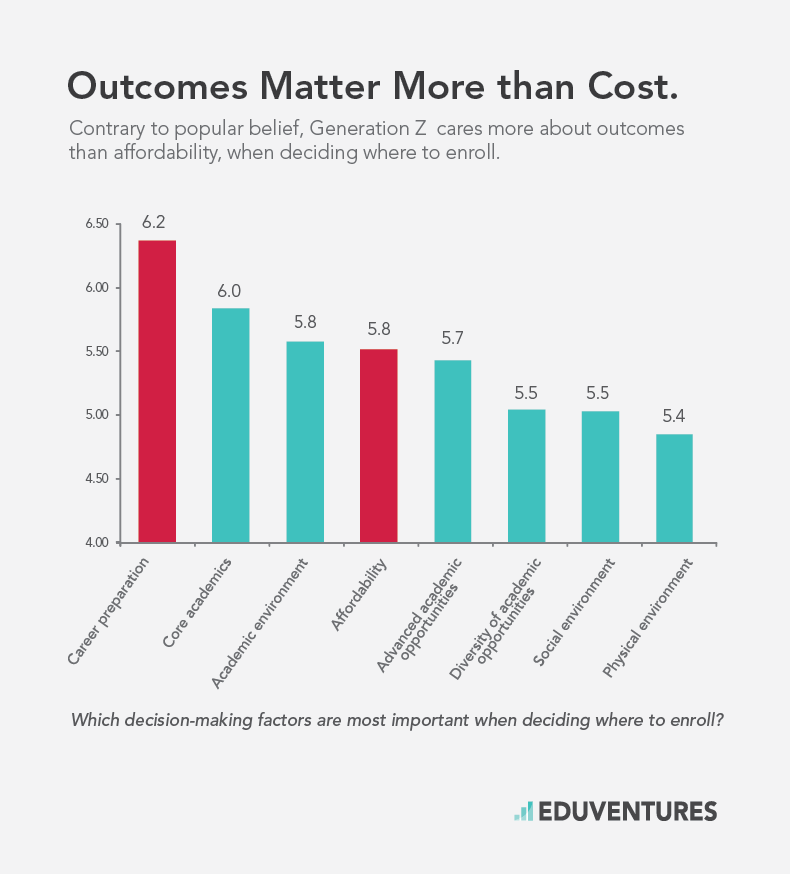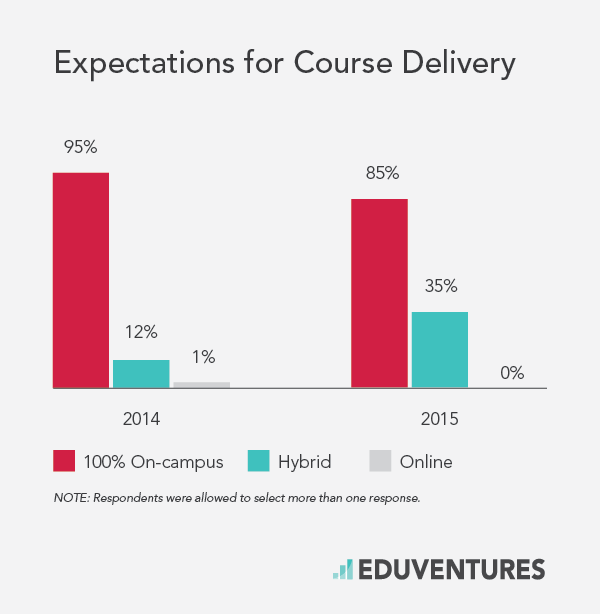As we witness transformation across higher education, history can guide us. Many innovations started with non-traditional students and went on to redefine traditional education. For example, the SAT was developed from an aptitude test for the military, and community colleges were positioned to serve adults in their earlier incarnations.
Knowing what we do about this pattern of innovation and the current market landscape, what can we anticipate about the next wave of change? From our perspective, the influence of technology on educational delivery models is likely the biggest challenge on the horizon. Short of predicting exactly what the delivery of a so-called traditional education will look like in ten years, we can safely say that it will be vastly different.
Looking forward, several factors will influence which innovations take root to shape the next generation experience for traditional-age (18-24-year-old) students. Chief among these is the increasing importance of perceived value, as students and their parents consider their options more carefully. Results from the Eduventures 2015 Prospective Student Survey demonstrate that students and their families are balancing the benefits of a college education against the costs.
 A part of this value proposition is blending field experience into the academic offering. Experiential opportunities have earned a much more prominent place in these conversations. The intertwining and inseparable story of academic learning with learning in the “real world” is now foundational to the narrative of every institution’s value proposition.
Add to this the reality of a long-anticipated demographic shift setting in. Each class going forward will be more racially, ethnically, and socio-economically diverse and include more first-generation students than the last. Moreover, we are seeing a regional shift, as the percentage of students from traditionally overweighted regions, like the Northeast, shrinks and the percentage of students from underweighted regions, like the Southeast, grows. On top of all this, institutions are battling for international students. These demographic factors have created a new basis of competition as institutions fight for market share.
As schools wrestle with this evolving value proposition and the ongoing demographic shift, they also have to embrace the fact that disruptive technology abounds. Schools that don’t stay on the technology learning curve could find themselves at a competitive disadvantage that will be difficult to recover from. This is especially true of liberal arts colleges that have been able to sustain their traditional models throughout the first wave of technology-driven innovation in higher education. Remember how the rapid rise of the internet blindsided many market leaders, while upstarts and more agile competitors stole their markets (e.g. Borders Books, Circuit City, Toys R Us, and KMart)?
The above trends aside, we recognize that many traditional-aged college students still want an archetypal college experience; however, they intuitively understand it should be different, even if they don’t quite know how. Ultimately, these students are still 18 year olds with the social, emotional, and cognitive development of relatively inexperienced young adults. They want the intense coming of age interaction with peers and professors that has been at the heart of higher education for many generations. At the same time, they are digital natives who seamlessly integrate technology into their lives. Eduventures data shows that traditional-aged prospective students are beginning to believe they can still get the interaction they crave through hybrid education. If it’s not already true, schools will soon find that if they deliver education exclusively in classrooms or use technology only for transactional interactions, they will fail to meet the changing expectations of traditional students.
A part of this value proposition is blending field experience into the academic offering. Experiential opportunities have earned a much more prominent place in these conversations. The intertwining and inseparable story of academic learning with learning in the “real world” is now foundational to the narrative of every institution’s value proposition.
Add to this the reality of a long-anticipated demographic shift setting in. Each class going forward will be more racially, ethnically, and socio-economically diverse and include more first-generation students than the last. Moreover, we are seeing a regional shift, as the percentage of students from traditionally overweighted regions, like the Northeast, shrinks and the percentage of students from underweighted regions, like the Southeast, grows. On top of all this, institutions are battling for international students. These demographic factors have created a new basis of competition as institutions fight for market share.
As schools wrestle with this evolving value proposition and the ongoing demographic shift, they also have to embrace the fact that disruptive technology abounds. Schools that don’t stay on the technology learning curve could find themselves at a competitive disadvantage that will be difficult to recover from. This is especially true of liberal arts colleges that have been able to sustain their traditional models throughout the first wave of technology-driven innovation in higher education. Remember how the rapid rise of the internet blindsided many market leaders, while upstarts and more agile competitors stole their markets (e.g. Borders Books, Circuit City, Toys R Us, and KMart)?
The above trends aside, we recognize that many traditional-aged college students still want an archetypal college experience; however, they intuitively understand it should be different, even if they don’t quite know how. Ultimately, these students are still 18 year olds with the social, emotional, and cognitive development of relatively inexperienced young adults. They want the intense coming of age interaction with peers and professors that has been at the heart of higher education for many generations. At the same time, they are digital natives who seamlessly integrate technology into their lives. Eduventures data shows that traditional-aged prospective students are beginning to believe they can still get the interaction they crave through hybrid education. If it’s not already true, schools will soon find that if they deliver education exclusively in classrooms or use technology only for transactional interactions, they will fail to meet the changing expectations of traditional students.

 A part of this value proposition is blending field experience into the academic offering. Experiential opportunities have earned a much more prominent place in these conversations. The intertwining and inseparable story of academic learning with learning in the “real world” is now foundational to the narrative of every institution’s value proposition.
Add to this the reality of a long-anticipated demographic shift setting in. Each class going forward will be more racially, ethnically, and socio-economically diverse and include more first-generation students than the last. Moreover, we are seeing a regional shift, as the percentage of students from traditionally overweighted regions, like the Northeast, shrinks and the percentage of students from underweighted regions, like the Southeast, grows. On top of all this, institutions are battling for international students. These demographic factors have created a new basis of competition as institutions fight for market share.
As schools wrestle with this evolving value proposition and the ongoing demographic shift, they also have to embrace the fact that disruptive technology abounds. Schools that don’t stay on the technology learning curve could find themselves at a competitive disadvantage that will be difficult to recover from. This is especially true of liberal arts colleges that have been able to sustain their traditional models throughout the first wave of technology-driven innovation in higher education. Remember how the rapid rise of the internet blindsided many market leaders, while upstarts and more agile competitors stole their markets (e.g. Borders Books, Circuit City, Toys R Us, and KMart)?
The above trends aside, we recognize that many traditional-aged college students still want an archetypal college experience; however, they intuitively understand it should be different, even if they don’t quite know how. Ultimately, these students are still 18 year olds with the social, emotional, and cognitive development of relatively inexperienced young adults. They want the intense coming of age interaction with peers and professors that has been at the heart of higher education for many generations. At the same time, they are digital natives who seamlessly integrate technology into their lives. Eduventures data shows that traditional-aged prospective students are beginning to believe they can still get the interaction they crave through hybrid education. If it’s not already true, schools will soon find that if they deliver education exclusively in classrooms or use technology only for transactional interactions, they will fail to meet the changing expectations of traditional students.
A part of this value proposition is blending field experience into the academic offering. Experiential opportunities have earned a much more prominent place in these conversations. The intertwining and inseparable story of academic learning with learning in the “real world” is now foundational to the narrative of every institution’s value proposition.
Add to this the reality of a long-anticipated demographic shift setting in. Each class going forward will be more racially, ethnically, and socio-economically diverse and include more first-generation students than the last. Moreover, we are seeing a regional shift, as the percentage of students from traditionally overweighted regions, like the Northeast, shrinks and the percentage of students from underweighted regions, like the Southeast, grows. On top of all this, institutions are battling for international students. These demographic factors have created a new basis of competition as institutions fight for market share.
As schools wrestle with this evolving value proposition and the ongoing demographic shift, they also have to embrace the fact that disruptive technology abounds. Schools that don’t stay on the technology learning curve could find themselves at a competitive disadvantage that will be difficult to recover from. This is especially true of liberal arts colleges that have been able to sustain their traditional models throughout the first wave of technology-driven innovation in higher education. Remember how the rapid rise of the internet blindsided many market leaders, while upstarts and more agile competitors stole their markets (e.g. Borders Books, Circuit City, Toys R Us, and KMart)?
The above trends aside, we recognize that many traditional-aged college students still want an archetypal college experience; however, they intuitively understand it should be different, even if they don’t quite know how. Ultimately, these students are still 18 year olds with the social, emotional, and cognitive development of relatively inexperienced young adults. They want the intense coming of age interaction with peers and professors that has been at the heart of higher education for many generations. At the same time, they are digital natives who seamlessly integrate technology into their lives. Eduventures data shows that traditional-aged prospective students are beginning to believe they can still get the interaction they crave through hybrid education. If it’s not already true, schools will soon find that if they deliver education exclusively in classrooms or use technology only for transactional interactions, they will fail to meet the changing expectations of traditional students.

What’s Next?
Eduventures believes that the future will be defined by many more paths to a degree for traditional-aged students, some that look like “college” and some that diverge towards what is now considered non-traditional. Schools that want to remain competitive will need to balance the seemingly conflicting desire for tradition and nostalgia with new experiences and new ideas. It’s a complex endeavor to bring innovation that is both purposefully built to enhance the traditional student experience and aligned to your institutional mission. Successful institutions understand this and are consciously staying on the learning curve to keep pace with change. Getting onto this learning curve requires a complex, strategic, campus-wide discussion to imagine a new form of education that is resonant, relevant, and that drives results.- Formalize a dialogue, either through existing or ad hoc committees, about aspects of the traditional experience that are changing
- Include academic affairs, student affairs, and enrollment leadership for all segments of the student population, not just traditional students
- Address the product. Is it academically, experientially, and socially caught up to market expectations in its content and delivery?
- Communicate the ways in which the student experience holds onto the richness of a traditional college experience while positioning for the future.

